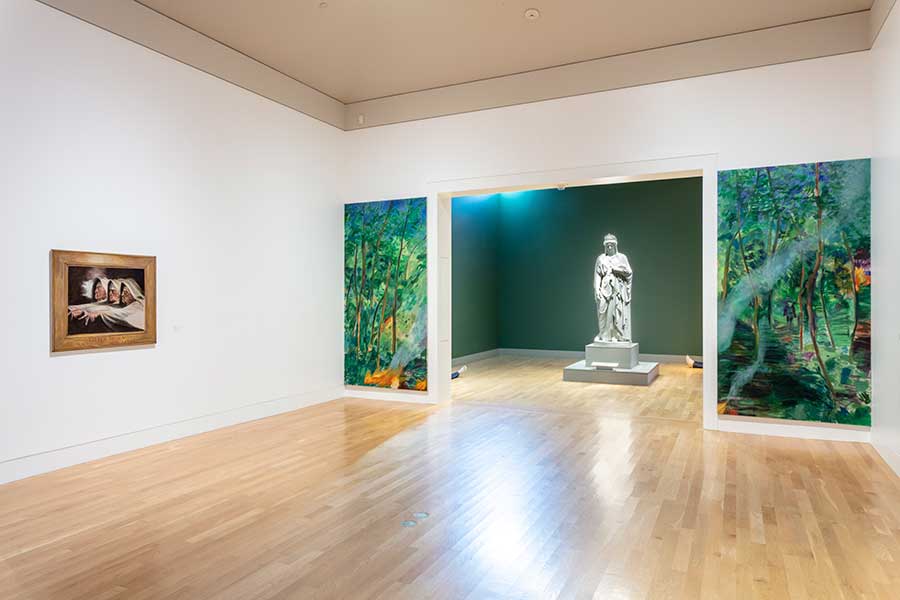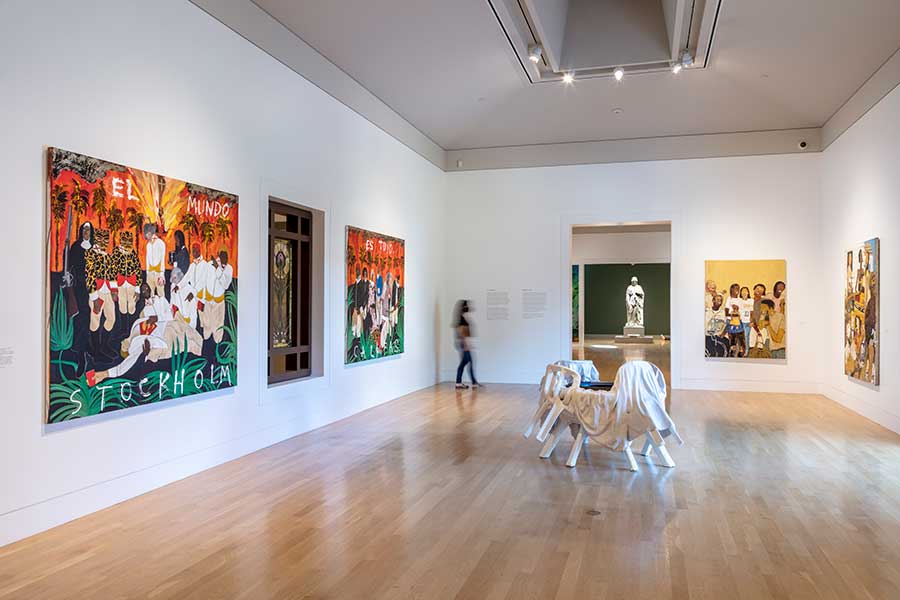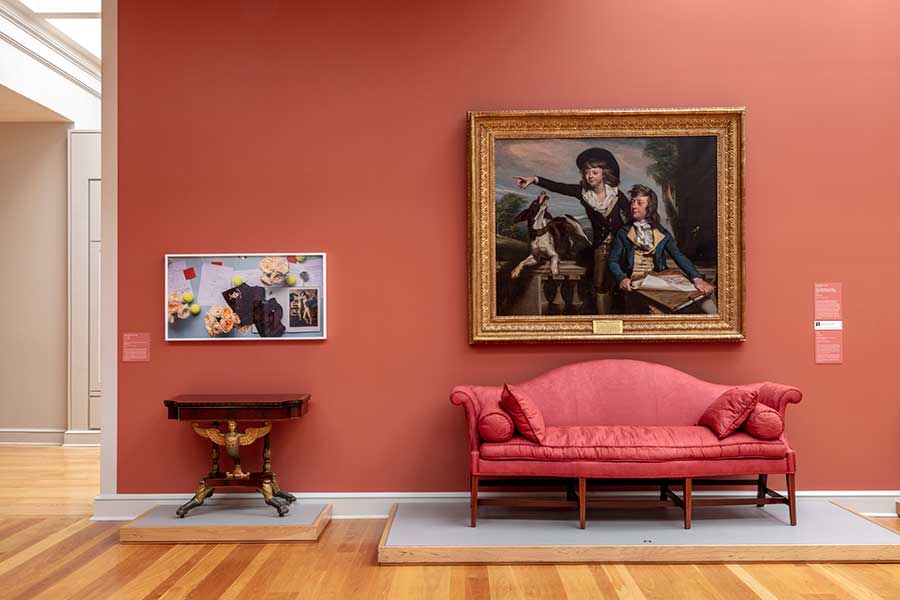The Huntington’s blog takes you behind the scenes for a scholarly view of the collections.
“Made in L.A. 2020: a version” Considers The Huntington’s Collections
Posted on Mon., April 19, 2021 by
![Nicola L.’s Pénétrables are on view in the Rothenberg Loggia of The Huntington’s Virginia Steele Scott Galleries of American Art. Nicola L., [left to right] Pénétrable (Cloud), Pénétrable (Flower), Pénétrable (Forest), Pénétrable (Forest), Pénétrable (We Don’t Want War), Pénétrable (Terre), 1970–78, dyed canvas, marker, wood. Nicola L. Estate. Photo by Joshua White.](/sites/default/files/verso/featured/verso_mila_1.jpg)
Nicola L.’s Pénétrables are on view in the Rothenberg Loggia of The Huntington’s Virginia Steele Scott Galleries of American Art. Nicola L., [left to right] Pénétrable (Cloud), Pénétrable (Flower), Pénétrable (Forest), Pénétrable (Forest), Pénétrable (We Don’t Want War), Pénétrable (Terre), 1970–78, dyed canvas, marker, wood. Nicola L. Estate. Photo by Joshua White.
The fifth iteration of the Hammer Museum's acclaimed biennial, "Made in L.A. 2020: a version," bridges east and west Los Angeles with complementary presentations at the Hammer and The Huntington. With the exhibition fully installed at both institutions and the galleries open to the public, former staff writer Giovana Romano Sanchez takes a peek at The Huntington's installation and provides a few insights.
Featuring the work of 30 emerging and under-recognized artists from the greater Los Angeles area, “Made in L.A. 2020: a version” presents mirroring exhibitions at the Hammer Museum and The Huntington—as well as at local sites like barbershops and hospital waiting rooms. At The Huntington, works by such artists as Diane Severin Nguyen, Umar Rashid, and Buck Ellison consider the institution’s collections, providing new, sometimes radical, perspectives.
Originally scheduled to open last summer and postponed due the COVID-19 pandemic, “Made in L.A. 2020: a version” was intended to be part of The Huntington’s Centennial Celebration. Christina Nielsen, The Huntington's Hannah and Russel Kully Director of the Art Museum, says of the exhibition: "Just as scholars and students make use of The Huntington's diverse collections for their research, a number of the artists shown here have taken our diverse holdings in art, the botanical gardens, and the library as points of departure for their own work. This is a powerful reminder that our historic collections are deeply relevant today, and that The Huntington is a place for important conversations about art that matters, both past and present."
Some of the works presented in the exhibition seek to connect with The Huntington’s collections in direct, inventive ways. In the entrance to the Virginia Steele Scott Galleries of American Art, for example, the visitor encounters the experimental art of the late Nicola L. Her Pénétrables, six canvases shaped as human bodies, dyed in natural hues, are meant to be worn by performers. Representing natural elements, the canvases face outward, toward the botanical gardens at The Huntington, suggesting a dialogue with nature that can be mediated by the human body.

Patrick Jackson’s Heads, Hands, and Feet features human-modeled figures, like the ones whose feet are visible here, that lie supine on the floor near Harriet Goodhue Hosmer’s monumental sculpture, Zenobia in Chains. Jill Mulleady’s Interior of a Forest (diptych) frames Zenobia with a burning trail in a wooded scene. On the wall to the left is The Three Witches, Mulleady’s replica of Henry Fuseli’s painting of the same title in the Huntington Art Gallery; in her version, Mulleady has replaced the face of Fuseli’s leftmost witch with a self-portrait. Patrick Jackson, Head, Hands and Feet, 2011, resin, silicone, human hair, yak hair, denim clothing, 72 × 28 × 9 in. (182.9 × 71.1 × 22.9 cm). Courtesy of the artist and François Ghebaly, Los Angeles. Jill Mulleady, Interior of a Forest (diptych), 2020, oil on linen, 112 × 51 3/16 in. (284.5 × 130 cm). Courtesy of the artist. Jill Mulleady, The Three Witches, 2020, oil on linen, 36 1/4 × 40 15/16 in. (92 × 104 cm). Courtesy of the artist. Photo by Joshua White.
The paintings of Jill Mulleady create conversations across time and space. For “Made in L.A. 2020: a version,” the artist painted a replica of The Huntington’s hallmark work: Henry Fuseli’s painting The Three Witches (ca. 1785); surprisingly, she included a caricature of her own face as one of the witches, and she added the flash glare of a photograph behind it. Mulleady also engaged with a key sculpture at The Huntington: Harriet Goodhue Hosmer’s Zenobia in Chains (1859). In her diptych Interior of a Forest, a reworking of a painting with the same title by Paul Cézanne (ca. 1885), Mulleady frames the entrance of the room where Zenobia is placed with a wooded scene, punctuated by smoke and fire.
Zenobia is also a reference for Patrick Jackson and Ann Greene Kelly. Unlike the upright, monumental Zenobia, Jackson’s human-scale figures lie on the floor with their eyes sealed and mouths shut—evoking archetypes of violence. Opposite Zenobia, Kelly presents a sculpture of leaning chairs draped with white fabric, producing a texture that reveals shapes and gives implied movement to inert objects, making a visual connection to the drape of Zenobia’s elaborate dress.

Ann Greene Kelly’s Table appears opposite Harriet Goodhue Hosmer’s sculpture Zenobia in Chains in The Huntington’s Virginia Steele Scott Galleries of American Art. On the left wall is a diptych by Umar Rashid; on the front and right walls, works by Brandon Landers. Ann Greene Kelly, Table, 2020, plaster, wood, fabric, tire, aluminum, plastic, graphite, colored pencil, paper, 54 × 54 × 30 in. (137.2 × 137.2 × 76.2 cm). Courtesy of the artist, Chapter NY, and Michael Benevento, Los Angeles. Left wall: Umar Rashid, Stockholm, Califas 1795. Adios Sancho, mi torturador. Todavia te queiro. (Goodbye Sancho, my tormentor. I still love you.) On the colonized mind, or a possible escape into apathy. Or unbridled joy upon the death of your oppressor, followed by raucous laughter, 2020, acrylic on canvas (diptych), (Left): 72 × 84 in. (182.9 × 213.4 cm), (Right): 72 × 84 in. (182.9 × 213.4 cm). Courtesy of the artist. Front wall: Brandon Landers, R R, 2020, oil on canvas, 67 5/8 × 51 1/4 in. (171.8 × 130.2 cm). Courtesy of the artist. Right wall: Brandon Landers, Thursday , 2020, oil on canvas, 74 5/8 × 55 in. (189.5 × 139.7 cm). Courtesy of the artist. Photo by Joshua White.
Some of the links between the artists’ works and The Huntington’s collections are emphasized through juxtaposition. Buck Ellison’s highly detailed photographs exploring American wealth, for example, take on new meaning when displayed in The Huntington’s permanent collection galleries. “We made a space for him in our galleries so that the connections are even more potent,” says Dennis Carr, The Huntington’s Virginia Steele Scott Chief Curator of American Art. “He’s exposing issues of privilege and status around which The Huntington’s formative collections were built.”

Buck Ellison’s photograph Untitled (Cufflinks), left, appears alongside John Singleton Copley’s The Western Brothers in The Huntington’s Virginia Steele Scott Galleries of American Art. Buck Ellison, Untitled (Cufflinks), 2020, archival pigment print, 21 7/8 × 41 in. (55.6 × 104.1 cm). Courtesy of the artist, Balice Hertling, Paris, and Sunday Painter, London. Photo by Joshua White.
The Huntington is constantly being re-imagined and recontextualized by scholars, students, visitors, and artists. The partnership with the Hammer showcases these re-imaginings. As Dennis Carr puts it, “Made in L.A. 2020: a version” offers The Huntington the chance “to work with a broader community of contemporary artists who can share their own stories and their own histories in ways that link very specifically with The Huntington's historical collections.”
"Made in L.A. 2020: a version" is co-curated by independent curators Myriam Ben Salah and Lauren Mackler, with the Hammer's Ikechukwu Onyewuenyi as assistant curator of performance. Learn more about where to see offsite projects by Larry Johnson and Kahlil Joseph, on view now.
Hammer Museum members and visitors to the Hammer receive passes granting free admission to The Huntington to view the exhibition in full.
Sign up to receive the latest news about the exhibition's online programs and more.
Giovana Romano Sanchez is the former communications specialist in the Office of Communications and Marketing at The Huntington.